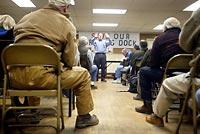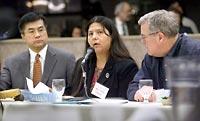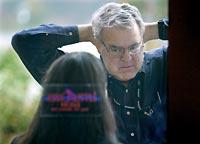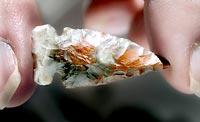Originally published May 24, 2005 at 12:00 AM | Page modified March 16, 2010 at 5:00 PM
"Walking together" meant walking away from project
The discovery of an Indian archaeological site where the state had hoped to build a dry dock turned into an expensive learning process for both the state and the Lower Elwha Klallam tribe.
Seattle Times staff reporter
STEVE RINGMAN / THE SEATTLE TIMES
Doug MacDonald, secretary of the state Department of Transportation, standing, explains to angry construction workers and community members gathered at a union hall in Port Angeles why the state shut down a dry-dock project there after spending $60 million. Some city officials and local legislators are still lobbying to restart the project.
STEVE RINGMAN / THE SEATTLE TIMES
Then Gov. Gary Locke, right, and Transportation Secretary Doug MacDonald confer after an emotional meeting with tribal leaders angered and hurt by violation of Klallam ancestral graves at Tse-whit-zen. The village was inadvertently discovered during a state construction project in Port Angeles.
Frances Charles, chairwoman of the Lower Elwha Klallam Tribe, speaks about the project with then Gov. Gary Locke, left, and Transportation Secretary Doug MacDonald at the meeting with tribal officials from around the state in Olympia.
Transportation Secretary Doug MacDonald, here speaking with tribal chairwoman Frances Charles, says the collapse of the project shows the continuing lack of an effective relationship between tribes and non-Indians. He took the need for reconciliation to heart, even taking his mother to a sacred burning ceremony as a first step in negotiations with the Lower Elwha.
PORT ANGELES — At least 27 centuries ago, the Klallam people began using some of the finest real estate in the aboriginal world: a flat, sunny beach with a deep harbor protected by a sand spit.
Those same attributes attracted the state Department of Transportation a few years ago when it scouted for a place to build a massive dry dock.
Only after starting construction did the agency discover what was buried under a century of industrial fill: remnants of Tse-whit-zen, the largest Indian village ever discovered in Washington.
And they found graves. So many graves that the department eventually walked away from the site last December after spending about $60 million on the project and digging up the intact remains of 335 souls.
How such a major village site and burial ground could have been missed in the review of the site is a question that still dogs the agency.
The Klallams' ancestral villages on the Port Angeles waterfront had been documented in the general area of the project by scholars, historians and journalists since the 19th century. The Lower Elwha tribe had for generations passed along knowledge of a settlement at Tse-whit-zen.
And when a mill was built next door to the site in 1920, a headline in the local paper read: "Squatters and Indian Bones Bother Builders."
Yet when the transportation department geared up to dig a huge hole for the dry dock, it commissioned only a limited archaeological review and never questioned the finding that nothing was there.It turned out to be one of the department's costliest mistakes ever.
It also turned out to be an unusual opportunity for reconciliation between the Lower Elwhas, first pushed off this land more than a century ago, and the state.
No sense of history
When Transportation Secretary Doug MacDonald walked the site for the first time at a groundbreaking ceremony in August 2003, he saw only empty industrial land, party tents and local officials celebrating the jobs that would soon come to this town.
Here, seemingly, was the ideal site. It was big enough for a dry dock to build pontoons and anchors needed to rebuild not only the east half of the Hood Canal Bridge, but eventually, the 520 bridge across Lake Washington. There were no endangered-species show-stoppers, and no NIMBY (not in my back yard) complaints.
"If anybody had said, 'Do you understand that you are going to spend the next year and a half of your life dealing with the implications and the contents of this site in relation to Native Americans?' you would have said, 'You've come to the wrong party. I don't see any Native Americans here. Are there Native Americans here in Port Angeles?'" MacDonald said.
"The collective amnesia is so profound that no one ever even asked the question."
Port Angeles officials say they, too, saw only opportunity at the site. "It was, 'You need a spot; we've got a flat one,'" said Larry Williams, a member of the Port Angeles City Council. "I had no sense of the real history."
Glenn Hartmann, the archaeologist hired by the state to examine the property, didn't go to the site himself but sent staff to dig test trenches in wet ground with state equipment that repeatedly broke.
Hartmann did file a report full of yellow lights: He warned that paving prevented examining some areas, especially where undisturbed sediments were likely to be encountered; and that auger samples might not have detected buried archaeological deposits. The department also later shifted the footprint of its project to include an area outside of the survey, where the thickest concentration of burials was ultimately discovered.
This spear point glows with color. Stone points were painstakingly chipped and ground to a point sharp to the touch, then used to hunt fish, seal, elk or deer.
Whenever she found stone points at Tse-whit-zen, tribal member Wendy Sampson thought about all the work her ancestors put into making them.
Hartmann also noted that an ancestral Indian village called Tse-whit-zen and burial ground were somewhere in the area, and that Indian bones had been found next door.
Still, Hartmann concluded that finding archaeological deposits or human remains was "unlikely." He fell back on the just-in-case recommendation of his trade: monitor the site during construction.
The transportation department and state Office of Archaeology and Historic Preservation agreed that was good enough. The department announced its choice of the Port Angeles site even before receiving the report.
Not a single cultural-resources expert was on the interagency team reviewing the permits and construction sites for the Hood Canal Bridge project. Nor were they invited to the team's discussions.
By contrast, state and federal agencies thoroughly vetted environmental concerns. Every biologist in the transportation department worked on the project, checking for impacts on eelgrass, bald-eagle nests, salmon and more.
Elders not consulted
In November 2002, department managers singled out the Port Angeles site for its "predictability." Federal agencies had already done their review, and, finding no concerns, deemed an environmental-impact statement unnecessary.
"You might call it the perfect calm, rather than the perfect storm," MacDonald said. "No bells were going off at all."
The state sent its first letter about the project to the tribe in October, a month before choosing the site.
In February 2003, the tribe answered, agreeing with Hartmann's findings. But the tribe also warned that "proximity to known Klallam Village sites and traditional use areas argues strongly for caution." Unlike wealthier tribes, though, the Lower Elwha had no cultural-resources department and no archaeologist on staff to vet the state's proposal.
By then, the state had already purchased the property from the Port of Port Angeles. And no one — not state officials, the archaeologists they hired or the tribal council — consulted with tribal elders before work got under way.
If they had, Bea Charles, 86, and Adeline Smith, 87, might have told them of the burial ground there, knowledge they say was entrusted to them by the late tribal leader Sam Ulmer. "He told us about the cemetery in Tse-whit-zen, that it was there, and we were to remember it," Charles said.
Dennis Sullivan, tribal chairman at the time, said, "I didn't reach out to as many [of the elders] as I wanted to. This bothers me. It's been a very expensive learning process for us all."
State, tribe "walk together"
Work began in August. Within three weeks, workers pulling up concrete found bits of shell that are often evidence of previous settlements. The first human bones were dug up. Archaeological deposits were mistakenly trucked to the landfill.
MacDonald shut down the job Aug. 26, 2003. The tribe took its ancestral remains to a funeral home.
At the invitation of the tribe, MacDonald brought top project staff and even his mother to a sacred burning ceremony, where the spirits of the ancestors were fed full-course dinners, burned to ashes on cedar tables on the beach.
The project was on state land, so the tribe had no legal veto power over the project.
But MacDonald made it clear he wanted to "walk together" with the Lower Elwha to finish the project, as both sides often put it.
He offered a settlement agreement, not required by law, that included $3.4 million in return for the tribe's consent.
Six months went by as the tribe considered what to do, and the lobbying campaign by state, local and federal officials intensified. "It was, 'We can do this project with you or without you,'" said Frances Charles, current tribal chairwoman.
The tribe didn't want to seem the spoiler, and worried about backlash in the community. "And we were led to believe good things might happen. There was a lot of cooperative talk about a museum, and helping us find property for reburial," Sullivan said.
During a second site assessment, a human skull rolled out of the backhoe bucket, as workers digging in old utility trenches uncovered shattered human remains.
By now, everyone was certain more bones would be found. But they thought continuing the project would mean discovery of remains desecrated in past construction, and an opportunity to properly rebury them. They didn't expect to uproot a major burial ground.
The tribe signed the settlement agreement in March 2004.
"If I had known then what I know today, I'd never have agreed to it," Sullivan said. An intact skeleton was found within days. Then another, and another, all summer and into the fall. "We became very alarmed," Frances Charles said.
So did MacDonald: Instead of healing old wounds, the state was opening new ones.
The tribe asked that all burials be removed, in part so no ancestral remains would be left underneath the concrete floor of the dry dock. Stranding remains would split a community of spirits, tribal leaders said, and condemn the separated souls to search forever for the missing.
The state, already over budget and behind schedule, resisted.
By May, tribal leaders were asking for reconsideration of the project. By November, influential elders and spiritual advisers wanted it stopped.
"The ancestors here are so powerful: These old souls live," said tribal spiritual adviser Mary Anne Thomas of the Esquimalt Nation in Canada. "Let the cemetery remain a cemetery, because it is alive down at that site."
Thomas was hired, in part, to help tribal workers digging their ancestors out of the ground so construction could proceed. She wound up trying to explain to them why they felt a touch on their back or shoulder, why their tears would not stop, why they heard the sounds of wolves crying.
Some tribal members say they heard drums or saw the spirits of their ancestors, especially when they worked at the site at night, burning candles in respect and painting themselves with sacred red ochre for protection.
To save the project, the department tried just about everything: ground-penetrating radar. Calculating the pounds per square inch of pressure exerted by paving to assure the tribe that its ancestors wouldn't feel the concrete slab. Offering to search the ground with cadaver dogs. Obtaining a ruling from the federal government to limit the state's obligation to remove the graves.
"You thought you were going to lawyer this issue, then you thought you could engineer this issue," MacDonald said. "If you start building things in stupid little pieces, you get more stupid little pieces."
By December, work crews unearthed the 335th intact skeleton.
After 16 months of negotiations to keep the project going, the Lower Elwhas shifted course and asked the state to leave. MacDonald, with the backing of state and federal officials, agreed.
Reconciliation, once about agreeing to work together to complete the project, became about agreeing to leave it.
Lynda V. Mapes: 206-464-2736 or lmapes@seattletimes.com
UPDATE - 09:46 AM
Exxon Mobil wins ruling in Alaska oil spill case
NEW - 7:51 AM
Longview man says he was tortured with hot knife
Longview man says he was tortured with hot knife
Longview mill spills bleach into Columbia River
NEW - 8:00 AM
More extensive TSA searches in Sea-Tac Airport rattle some travelers
![]()

Entertainment | Top Video | World | Offbeat Video | Sci-Tech
general classifieds
Garage & estate salesFurniture & home furnishings
Electronics
just listed
More listings
POST A FREE LISTING







